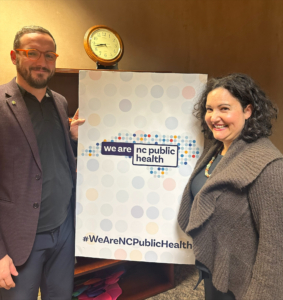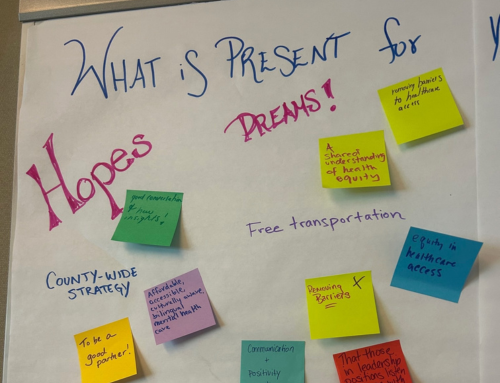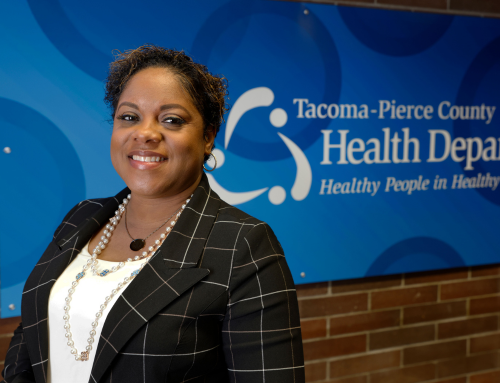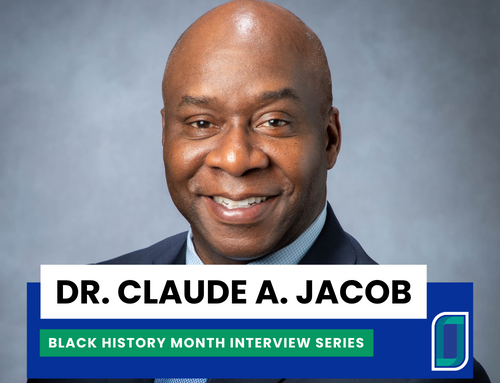Having a shared framework and language is crucial when addressing complex public health challenges. The North Carolina Department of Health and Human Services (NCDHHS) has adopted the Foundational Public Health Services (FPHS) framework, stewarded by the Public Health Accreditation Board (PHAB) Center for Innovation, as a roadmap for building infrastructure and delivering and prioritizing public health services.
The FPHS framework, designed to guide governmental public health, defines a minimum package of public health capabilities and programs that no community should be without. Not only does the FPHS outline the unique role of governmental public health and demonstrate its role in a thriving community, but it can support the department in identifying capacity and resource gaps and justifying funding needs.
Erin Fry Sosne, MPH, Director of Strategy at the Division of Public Health, NC Department of Health and Human Services, and Ryan Jury, RN, MBA, Assistant Director of Operational Excellence, emphasize the significance of the FPHS framework, particularly the Foundational Capabilities, in guiding their department’s efforts.
“…it’s really a foundational approach that we’ve been using in North Carolina to think about how we emphasize and prioritize our staffing capacity and resources,” Fry Sosne said.

Using the FPHS to Guide Strategic Direction
In the decentralized state of North Carolina, where the department relies heavily on federal funding, the FPHS framework has offered a lifeline. It enables them to advocate for public health by using the language of the FPHS to articulate their needs. By laying out the strengths and areas of opportunities, the FPHS framework has been instrumental in defining what public health departments should look like and what areas to focus on.
The FPHS framework also supports the NCDHHS’ implementation approach to the Public Health Infrastructure Grant (PHIG), a historic funding opportunity to strengthen public health infrastructure across the country. At the same time the department was writing its grant, they were also seeking national accreditation from PHAB. Having these concepts in mind during the accreditation process helped inform the strategic direction of other activities like PHIG.
“…[the FPHS] has been the driving factor behind the creation of our Public Health Infrastructure grant,” Jury noted. “We’ve used the framework to define infrastructure.”
The department started with an assessment to determine how to invest PHIG dollars to build out the Foundational Capabilities in the state. In collaboration with the University of North Carolina, the assessment included a regional and state-level gap analysis to understand their strengths and areas of opportunity, identify synergies, determine capacity, and allocate PHIG funds to bridge the gaps.
Building Capacity and Creating Shared Language
The department has focused heavily on the capacity – time, materials, resources, education, and expertise – needed to strengthen the Foundational Capabilities and work toward building that infrastructure.
“It’s not just about expertise; it’s also about capacity and ensuring that the right resources are allocated to the right areas,” Fry Sosne said.
Part of building capacity involves getting the right people in the right roles. Recently, the department recruited a communications manager. In their recruitment efforts, they used the FPHS framework to craft the job description, copying and pasting directly from the framework, to demonstrate the positions’ purpose, its responsibilities, and paint an accurate picture of success in the role.
“…we used the language from the FPHS in the justification for why we needed a communications manager as well as a number of the elements in the job description,” Fry Sosne said. “I put up recruitment for the job on LinkedIn where we used the [FPHS] graphic and we highlighted communications [as the Foundational Capability].”
Using language directly from the FPHS framework has also helped the department create shared language among staff and in public health. Jury emphasized that “fallacies of language” exist, where the same words can mean different things to different people. This difference in interpretation can pose a challenge when advocating for public health, creating policy, implementing programs, and hiring for roles. The FPHS framework addresses this issue by providing a common language that fosters a shared understanding of the core components of public health.
“…Erin and I are two colleagues who have different roles and responsibilities. What the framework has allowed us to do is to come into a space and have shared language,” Jury added. “… [shared language] is important from an advocacy and policy standpoint, but it’s also important from an implementation standpoint, setting expectations, and thinking about what success looks like for a job.”
Fry Sosne uses the framework during presentations and meetings to break down complex topics, making them accessible to staff from various backgrounds.
“During meetings and discussions, I often refer to the FPHS graphic and its language,” Fry Sosne shared. “It simplifies complex concepts, especially for those who haven’t been immersed in public health for long. It’s about fostering an environment of understanding.”
The FPHS framework can also be used as a tool to construct a narrative of impact. It equips health departments with a consistent and universal language to talk about their role and the positive changes they are driving within their communities. This is important when communicating the impact of public health initiatives to individuals unfamiliar with the field.
“…if I were a health department and I was having a hard time telling my story about impact or what it is we do, this framework would give me the basis to build off of,” Jury said.
Leading Transformation
North Carolina’s use of the FPHS is part of larger strategic efforts to transform public heath across the state, referred to by PHAB as the 21st Century approach to transformation. This approach centers on developing a vision and assessing and implementing strategies to integrate the FPHS more broadly across the state and involves collaborating with other states through PHAB’s 21st Century Learning Community (21C) to foster innovation and drive change. As a member of 21C, North Carolina and 17 other states are focused on intentional statewide public health system transformation using various approaches including but not limited to the FPHS and PHAB accreditation.
The FPHS framework is not just a tool, but a roadmap that guides public health efforts across the country. It supports resource allocation, creates shared language to align goals, and drives change to better serve community. North Carolina’s approach is an example of how the FPHS can be leveraged by departments to map out strategic direction and foster a shared vision for effective public health services.
—
Interested in learning more about 21st Century approaches to public health and PHAB Tools for Transformation? Reach out to us at [email protected]





